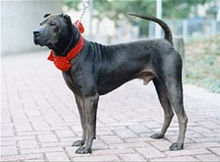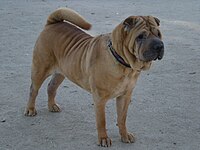Shar Pei
| Shar pei | |||||||||||||||||||||
|---|---|---|---|---|---|---|---|---|---|---|---|---|---|---|---|---|---|---|---|---|---|
 Modern "wrinkle-mouth" shar pei | |||||||||||||||||||||
 Traditional "bone-mouth" shar pei | |||||||||||||||||||||
| Other names |
| ||||||||||||||||||||
| Origin | China | ||||||||||||||||||||
| |||||||||||||||||||||
| |||||||||||||||||||||
| Dog (domestic dog) | |||||||||||||||||||||
The shar pei (Chinese: 沙皮; Cantonese Yale: shā pèih; pinyin: shā pí) is a dog breed from southern China. Traditionally kept as a property guardian, the shar pei was driven to the brink of extinction in the 20th century. The breed is known in the West for its deep wrinkles, while a traditional less wrinkled form is maintained in Hong Kong.
History

There are no records indicating the origins of the shar pei, although it closely resembles effigies of an un-wrinkled type of guard dog kept in southern China during the Han dynasty; some believe the modern breed, along with the chow chow, descends from these dogs.[2][3] The breed has been identified as a basal breed that predates the emergence of the modern breeds in the 19th century.[4]
The shar pei was once very popular, but war and political turmoil in China in the 20th century took its toll on the breed and by the 1970s it was close to extinction.[2][3] In 1973 a Hong Kong businessman named Matgo Law appealed to the international community, in particular the American Kennel Club, to help save the breed; by 1978 the breed was named by The Guinness Book of Records as the world’s rarest breed, with only 60 remaining.[2][3][5] The resultant publicity led to great demand in the United States for examples of the breed, and unscrupulous breeders in Hong Kong, Macau and Taiwan took to crossing their remaining purebred animals with other breeds including the bull terrier, pug and bulldog, and selling the offspring to unwitting American buyers.[3] The results of the crossings led to a dog with a much fleshier mouth than the original breed, these dogs became known as "meat-mouth" shar peis, while the original dogs are called "bone-mouth" shar peis.[3]
The cause of saving the breed was taken up in the United States by enthusiastic breeders using the dogs smuggled there in the 1970s, a breed club was founded and it received American Kennel Club recognition in 1992, with breed standard specifying a meat-mouth type dog.[2][3] Some breeders in Hong Kong maintain the traditional bone-mouth type, although it is estimated only 50 to 100 examples of this type remain.[3]
In the United States, a number of breeders have selectively bred shar peis for a smaller size, creating what they call the "miniature shar pei", much to the opposition of many breeders of traditionally sized shar peis.[2] Standing to a maximum 40 centimetres (16 in), the miniature shar pei is bred for both for its smaller size and increased wrinkles.[2]
Description

The shar pei is a short-coated medium-sized breed of dog, renowned for its excessively wrinkled skin. The breed resembles many dog breeds from the mastiff family; however, it is most closely related to spitz breeds, with the chow chow being its closest relative. This is most clearly seen with the two breeds both possessing unique blue-black tongues.[2][5][6] This dog falls within the same genetic group as the chow-chow, the akita, the shiba inu, the malamute and the Greenland dog.[7]
Adult shar peis typically stand between 44 and 51 centimetres (17 and 20 in) and weigh between 16 and 20 kilograms (35 and 44 lb), they have a short, very harsh coat that can be any solid colour except white, although black, red, fawn and cream are the most common.[5][8]
The Chinese breed standard states they have clam-shell ears, butterfly nose, melon-shaped head, grandmotherly face, water buffalo neck, horse's buttocks and dragon's legs.[5] The breed's head is relatively large compared to its body with a broad muzzle that usually darker than the rest of the coat and well padded causing a bulge at its base, the ears are set wide apart and are small and triangular, and the eyes are set very deeply into the folds of skin on the head.[5][8] The breed has straight, well boned, muscular legs below sloping shoulders and a medium length broad tail that is curled over their back in a manner typical of spitz-type dogs.[5][8]
Health
Because of its popularity after being introduced to North America in the 1970s, the breed suffered much inexperienced or rushed breeding.[citation needed] While this resulted in a dramatically different look for the shar pei, as its most distinctive features were exaggerated, including its wrinkles and rounded snout, it also created many health problems.[9] The American club for the breed states that few shar peis reach the age of 10, and it has a longevity program recording those that live beyond that age.[10]
Compared to other breeds, shar peis have an increased risk of developing atopic dermatitis, a chronic allergic skin disease.[11] Dogs with allergic skin disease often get allergy-induced skin infections.[12] Shar peis are also at an increased risk of demodicosis,[13] a disease which happens when Demodex canis mites proliferate and cause skin irritation, inflammation and infection.[14]
Familial shar pei fever (FSF) is a serious congenital disease that causes short fevers lasting from 24 hours to sometimes up to three days and usually accompanied by accumulation of fluid around the ankles (called Swollen Hock Syndrome).[15] Amyloidosis, a long-term condition, is most likely related to FSF, caused by unprocessed amyloid proteins depositing in the organs, most often in the kidneys or liver, leading eventually to kidney failure.[citation needed] The disease is associated with the Western type and it is estimated that 23% are affected.[16] The Australian breed standard was changed in 2009 to discourage breeding for heavy wrinkling.[17]
A common problem is a painful eye condition, entropion, in which the eyelashes curl inward, irritating the eye. If untreated, it can cause blindness. This condition can be fixed by surgery—"tacking" up the eyelids so they will not roll onto the eyeball for puppies, or surgically removing extra skin in adolescent and older shar peis.[18] In Australia, more than eight in 10 shar peis require surgery to correct eye problems,[19] contributing to them being the most expensive breed to insure.[20]
The shar pei is also prone to yeast infections in its ears.[21] This is due to a tight inner ear structure with a wrinkled appearance, making cleaning very difficult; this is exacerbated by the tight "flap" that the ear creates over the canal, promoting a moist environment.[citation needed]
Vitamin B12 deficiency is a common problem in the shar pei and is suspected to be hereditary.[22][23]
See also
References
- ^ Indianapolis Museum of Art - Seated Shar Pei Dog
- ^ a b c d e f g Morris, Desmond (2001). Dogs: the ultimate dictionary of over 1,000 dog breeds. North Pomfret, VT: Trafalgar Square Publishing. pp. 355–357 & 563–564. ISBN 1-57076-219-8.
- ^ a b c d e f g "Discovering the Shar Pei: an endangered dog breed". Hong Kong Tatler. Hong Kong: Tatler Asia Limited. 23 Jul 2012. Retrieved 21 July 2020.
- ^ Larson, G (2012). "Rethinking dog domestication by integrating genetics, archeology, and biogeography". Proc. Natl. Acad. Sci. U.S.A. 109 (23): 8878–83. Bibcode:2012PNAS..109.8878L. doi:10.1073/pnas.1203005109. PMC 3384140. PMID 22615366.
- ^ a b c d e f Fogle, Bruce (2009). The encyclopedia of the dog. New York: DK Publishing. p. 254. ISBN 978-0-7566-6004-8.
- ^ Wilcox, Bonnie; Walkowicz, Chris (1995). Atlas of dog breeds of the world. Neptune City, N.J.: TFH Publications. p. 22.
- ^ Parker; et al. (2017). "Genomic Analyses Reveal the Influence of Geographic Origin, Migration, and Hybridization on Modern Dog Breed Development". Cell Reports. 19 (4): 697–708. doi:10.1016/j.celrep.2017.03.079. PMC 5492993. PMID 28445722. Figure 1
- ^ a b c Banks, Edward (2013). Dogs: the ultimate dog lover's guide. Sywell: Igloo Books Ltd. pp. 138–139. ISBN 978-1-78197-890-0.
- ^ "Shar Pei". www.pdsa.org.uk. Retrieved 2021-09-19.
- ^ Libman, Roberta. "CSPCA Longevity Program". Chinese Shar-Pei Club of America. Retrieved 14 August 2014.
- ^ Mazrier, Hamutal; Vogelnest, Linda J.; Thomson, Peter C.; Taylor, Rosanne M.; Williamson, Peter (June 2016). "Canine atopic dermatitis: breed risk in Australia and evidence for a susceptible clade". Veterinary Dermatology. 27 (3): 167–e42. doi:10.1111/vde.12317. PMID 27188769.
- ^ Saridomichelakis, Manolis N.; Olivry, Thierry (January 2016). "An update on the treatment of canine atopic dermatitis". The Veterinary Journal. 207: 29–37. doi:10.1016/j.tvjl.2015.09.016. PMID 26586215. S2CID 9511235.
- ^ Plant, Jon D.; Lund, Elizabeth M.; Yang, Mingyin (February 2011). "A case-control study of the risk factors for canine juvenile-onset generalized demodicosis in the USA". Veterinary Dermatology. 22 (1): 95–99. doi:10.1111/j.1365-3164.2010.00922.x. PMID 20707860.
- ^ Koch, Sandra N. (January 2017). "Dermatology details: Updates on the management of canine demodicosis". Today's Veterinary Practice. 7 (1): 77–85. Retrieved 2017-01-26.
- ^ "Familial Shar-Pei Fever". www.petmd.com. Retrieved 2021-09-19.
- ^ Olsson, M.; Meadows, J. R. S.; Truvé, K.; Rosengren Pielberg, G.; Puppo, F.; Mauceli, E.; Quilez, J.; Tonomura, N.; Zanna, G.; Docampo, M. J.; Bassols, A.; Avery, A. C.; Karlsson, E. K.; Thomas, A.; Kastner, D. L.; Bongcam-Rudloff, E.; Webster, M. T.; Sanchez, A.; Hedhammar, A.; Remmers, E. F.; Andersson, L.; Ferrer, L.; Tintle, L.; Lindblad-Toh, K. (2011). Georges, Michel (ed.). "A Novel Unstable Duplication Upstream of HAS2 Predisposes to a Breed-Defining Skin Phenotype and a Periodic Fever Syndrome in Chinese Shar Pei Dogs". PLOS Genetics. 7 (#3): e1001332. doi:10.1371/journal.pgen.1001332. PMC 3060080. PMID 21437276.
{{cite journal}}: CS1 maint: unflagged free DOI (link) - ^ Murphy, Bridget (18 March 2011). "How Shar Pei dogs got their wrinkles". Cosmos. Retrieved 18 April 2011.
- ^ Gelatt, Kirk N. (ed.) (1999). Veterinary Ophthalmology (3rd ed.). Lippincott, Williams & Wilkins. ISBN 978-0-683-30076-5.
{{cite book}}:|author=has generic name (help) - ^ Ryan, Kelly (18 April 2011). "Wrinkly dogs get nip and tuck". Herald Sun. Retrieved 18 April 2011.
- ^ "What is the Most Expensive Breed of Dog to Insure In Australia". Top10 Pet Insurance. 28 April 2017.
- ^ Meyers, Harriet (June 5, 2023). "Yeast Infections in Dogs: Everything You Need to Know". American Kennel Club. Retrieved 2023-07-28.
- ^ Grützner, Niels; Bishop, Micah A.; Suchodolski, Jan S.; Steiner, Jörg M. (1 March 2010). "Association Study of Cobalamin Deficiency in the Chinese Shar Pei". Journal of Heredity. 101 (2): 211–217. doi:10.1093/jhered/esp100. ISSN 0022-1503. PMID 19926684.
- ^ Bishop, Micah A.; Xenoulis, Panagiotis G.; Berghoff, Nora; Grützner, Niels; Suchodolski, Jan S.; Steiner, Jörg M. (1 January 2012). "Partial characterization of cobalamin deficiency in Chinese Shar Peis". The Veterinary Journal. 191 (1): 41–45. doi:10.1016/j.tvjl.2011.05.008. PMID 21652239.


